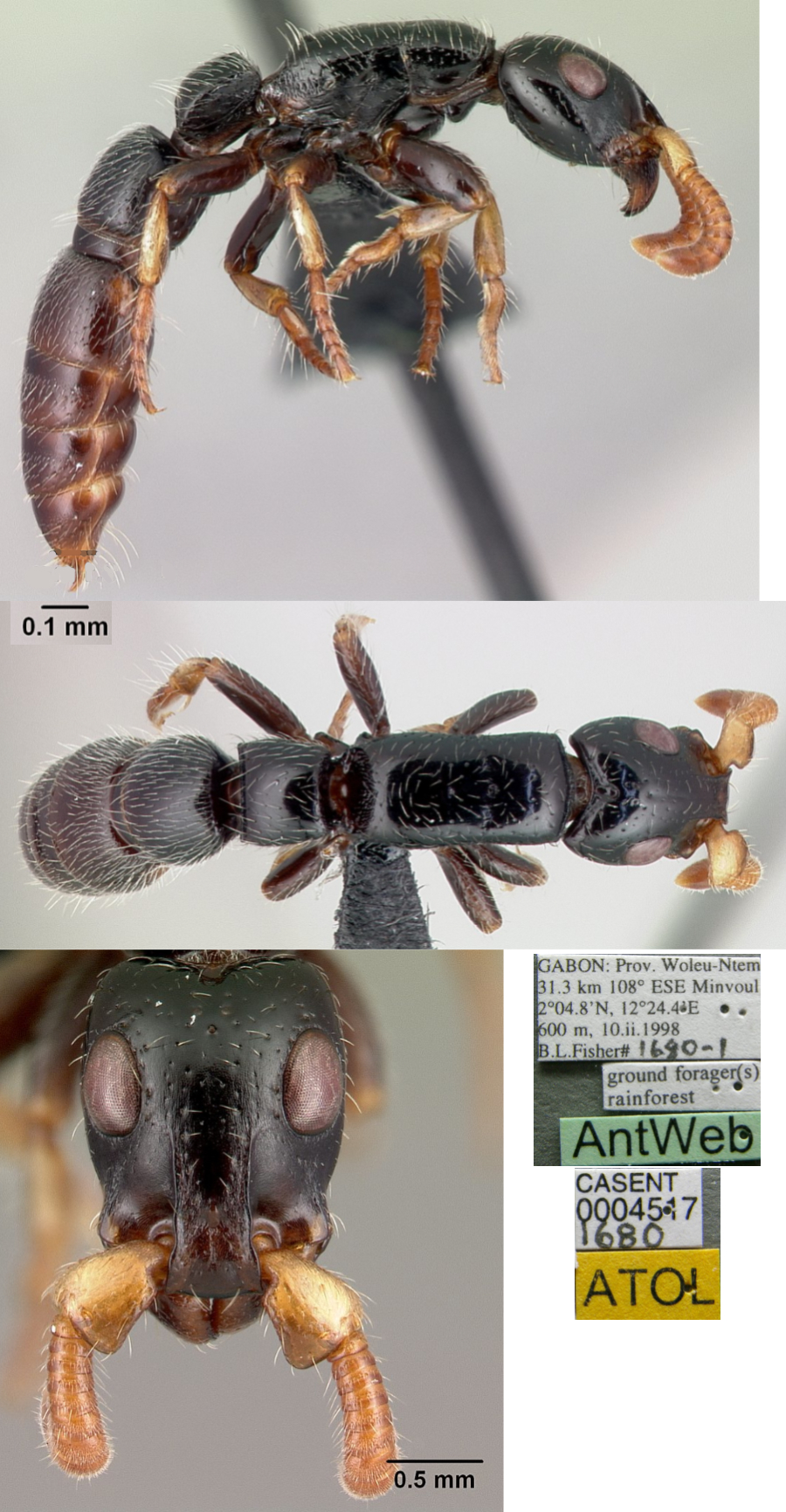Simopone latiscapa Bolton & Fisher
  Type location Ghana (Bolton
& Fisher, 2012: 29, illustrated, worker & queen) Tafo, K2,
12.ii.1974 (C. Campbell) (BMNH) Type location Ghana (Bolton
& Fisher, 2012: 29, illustrated, worker & queen) Tafo, K2,
12.ii.1974 (C. Campbell) (BMNH)  . .
|
WORKER
(holotype in parentheses). HL 1.80–1.96 (1.96), HW 1.32–1.48 (1.46), SL
0.62–0.70 (0.68), EL 0.54– 0.62 (0.60), PW 1.00–1.14 (1.12), AIIW
0.94–1.09 (1.09), AIIL 0.90–1.03 (1.03), AIIIW 1.16–1.35 (1.35), AIIIL
1.03–1.20 (1.20), WL 2.00–2.30 (2.30), MFL 1.04–1.20 (1.20), CI 73–76
(74), SI 47 (47), EL/HW 0.41–0.42 (0.41), EP 1.82–1.91 (1.91),
AIIW/AIIL 1.04–1.06 (1.06), AIIIW/AIIIL 1.13–1.14 (1.13) (3 measured).
Clypeus strongly reflexed so that the clypeo-labral junction is
conspicuously below and far behind the anteriormost point of the
apparent anterior margin. In full-face view the frontal lobes only
feebly elevated on each side of the clypeus. Frontal carinae extend
back almost or just to the level of the anterior margins of the eyes.
Eyes located well behind the cephalic midlength, EP > 1.50; in
full-face view outer margins of eyes just fail to break the outlines of
the sides at their midlengths. Sides of head behind eyes shallowly
convex, in front of eyes distinctly concave. Scape enormously flattened
and extremely broad, SW/SL 0.79–0.81, appearing disproportionately
massive in fullface view. Leading edge of scape with inclined
projecting setae present, and leading edge abruptly narrowed basally to
allow scape to move relative to the frontal lobes. Sides of head below
and behind eyes with projecting short setae present; cephalic dorsum
with standing setae present. Cephalic dorsum glossy, with scattered
punctures, the surface between the punctures with minute and faint
microreticular patterning. In dorsal view pronotum with a conspicuous
anterior carina that is reinforced posteriorly by a number of short,
longitudinal cuticular ribs; humeri not sharply angulate; promesonotal
suture with short cuticular ribs. Metanotal groove vestigial to absent.
Entire dorsum of mesosoma sculptured as the head but the superficial
microreticulation fainter and tending to fade out posteriorly. Dorsal
surfaces of mesosoma with numerous curved setae that vary from suberect
to almost decumbent. AII (petiole) without a distinct transverse
anterior carina, instead with an accentuated angle where anterior and
dorsal surfaces meet; posteriorly with a very weak carina. In dorsal
view the sides of AII shallowly convex, broadest at about the midlength
then converging posteriorly; posterior corners produced into a small,
bluntly triangular outcurved prominence on each side. Anteroventral
process of AII a recurved hook or spur. AII in dorsal view about as
long as broad, AIII and AIV distinctly broader than long; maximum width
of AIV 1.40–1.60, maximum length 1.04–1.28. Abdominal tergites, from
AII to apex, with numerous curved setae that are mostly subdecumbent to
decumbent; more elevated on posterior margin of each tergite; sternites
from AIII to apex also with setae. Femora and tibiae of middle and hind
legs with numerous, very conspicuous, elevated setae. Pygidial fork
short and stout, the pygidial margins on each side with a row of 9–10
spiniform denticles. Full adult colour of head and body black.
QUEEN (dealate gyne). HL 1.72–1.76, HW 1.27–1.34, SL 0.60–0.63, EL
0.52–0.56, PW 1.08–1.14, AIIW 0.94–0.96, AIIL 0.86–0.88, AIIIW
1.20–1.25, AIIIL 1.12, AIVW 1.42–1.44, AIVL 1.08–1.16, WL 2.26, MFL
1.08, CI 74–76, SI 47, SW/SL 0.73–0.76, EL/HW 0.41–0.42, EP 1.75,
AIIW/AIIL 1.06–1.12, AIIIW/AIIIL 1.08– 1.12 (2 measured). Matching the
description and general shape of the worker but the mesosoma with a
full complement of flight sclerites.
Holotype worker, Ghana: Tafo, K2, 12.ii.1974 (C. Campbell) (BMNH).
This spectacular species is immediately identified by its enormously
hypertrophied antennal scapes in both worker and queen. It is known
from only three workers and two queens; the Leston series from Ghana
(BMNH) consists of one of each and the other queen, from Sierra Leone,
was captured after it had flown into a house, though it was dealate
when discovered. |
 The photomontage of a non-paratypic worker from Gabon is
collated from http://www.antweb.org/specimen.do?name=casent0004517 The photomontage of a non-paratypic worker from Gabon is
collated from http://www.antweb.org/specimen.do?name=casent0004517
|
|